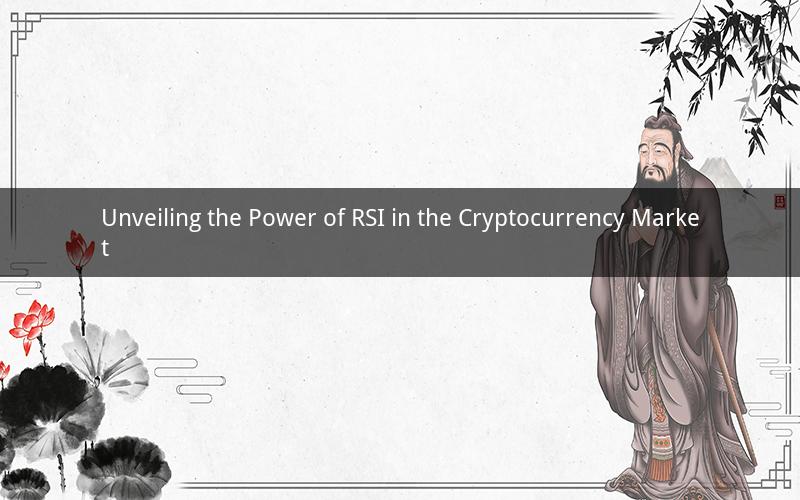
Introduction:
The term "RSI" in the cryptocurrency world stands for Relative Strength Index, a momentum indicator that measures the magnitude of recent price changes to evaluate overbought or oversold conditions in the market. This article delves into the meaning of RSI in crypto, its significance, and how it can be effectively utilized to make informed trading decisions.
1. Understanding RSI in Cryptocurrency
RSI is a technical analysis tool introduced by J. Welles Wilder Jr. in his book "New Concepts in Technical Trading Systems." It is widely used in various financial markets, including cryptocurrencies. The RSI ranges from 0 to 100 and is calculated by comparing the average gain of an asset over a specified period with the average loss.
2. How RSI Works in Cryptocurrency
The RSI is based on the premise that when an asset is overbought, it is likely to experience a pullback, and when it is oversold, it may bounce back. The formula to calculate RSI is as follows:
RSI = 100 - (100 / (1 + RS))
Where RS = Average Gain / Average Loss
3. Interpreting RSI Values
- RSI values above 70 indicate an overbought condition, suggesting that the asset may be due for a pullback or reversal.
- RSI values below 30 indicate an oversold condition, indicating that the asset may be undervalued and could potentially see a price increase.
- RSI values between 30 and 70 suggest a neutral market condition.
4. RSI Divergence and Crossovers
RSI divergence occurs when the price of an asset moves in a particular direction, but the RSI does not confirm the movement. This can be a sign of potential reversal. For example, if the price is making new highs, but the RSI is failing to reach new highs, it may indicate an overbought condition and a potential reversal.
Crossovers in the RSI occur when the indicator crosses above or below the 50-line. A crossover above the 50-line suggests bullish momentum, while a crossover below the 50-line suggests bearish momentum.
5. Combining RSI with Other Indicators
To enhance the effectiveness of RSI, it is often combined with other technical analysis tools. For example, the Fibonacci retracement levels can be used to identify potential support and resistance levels, which can be aligned with RSI readings for better decision-making.
6. RSI and Market Manipulation
It is important to note that RSI, like any other technical indicator, can be manipulated by market participants. Traders can use RSI to create false signals by buying or selling large amounts of cryptocurrency to push the indicator to overbought or oversold levels. Therefore, it is crucial to use RSI in conjunction with other indicators and analysis methods.
7. Limitations of RSI
While RSI is a powerful tool for analyzing market conditions, it has its limitations. For instance, RSI can generate false signals in highly volatile markets, where price action is unpredictable. Additionally, RSI does not provide information about the future direction of the market, but rather assesses the current momentum.
8. Real-World Examples of RSI in Cryptocurrency
Many successful traders have used RSI to identify profitable trading opportunities in the cryptocurrency market. For example, during the 2017 bull run, many traders used RSI to identify overbought conditions and exit their positions before a potential pullback. Similarly, during the bear market of 2018, RSI helped traders identify oversold conditions and enter long positions.
9. Conclusion
The Relative Strength Index (RSI) is a valuable tool for analyzing market conditions in the cryptocurrency world. By understanding its meaning, how it works, and its limitations, traders can effectively use RSI to make informed trading decisions. However, it is essential to combine RSI with other indicators and analysis methods to improve the accuracy of trading signals.
Questions and Answers:
1. Q: What is the significance of RSI in cryptocurrency trading?
A: RSI helps traders assess the current momentum of a cryptocurrency and identify overbought or oversold conditions, which can be used to make informed trading decisions.
2. Q: How does RSI compare to other technical indicators?
A: RSI is a momentum indicator that measures the magnitude of recent price changes. It is different from other indicators like moving averages, which are trend-following indicators. RSI is more suitable for identifying short-term trading opportunities.
3. Q: Can RSI be used for long-term investment strategies?
A: RSI is primarily designed for short-term trading strategies. While it can be used for long-term investment analysis, its effectiveness may be limited due to the high volatility in the cryptocurrency market.
4. Q: How can I combine RSI with other indicators for better trading decisions?
A: You can combine RSI with other indicators like Fibonacci retracement levels, moving averages, and volume analysis to identify potential support and resistance levels and confirm RSI signals.
5. Q: Are there any risks associated with using RSI in cryptocurrency trading?
A: Yes, RSI can generate false signals in highly volatile markets. Additionally, it is susceptible to market manipulation. It is crucial to use RSI in conjunction with other indicators and analysis methods to mitigate risks.